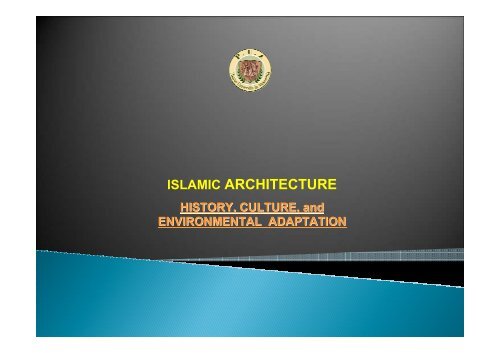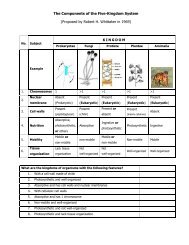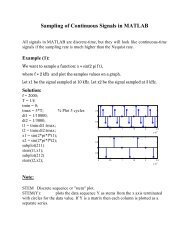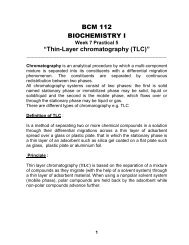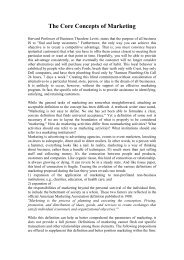ISLAMIC ARCHITECTURE - Pharos University in Alexandria
ISLAMIC ARCHITECTURE - Pharos University in Alexandria
ISLAMIC ARCHITECTURE - Pharos University in Alexandria
Create successful ePaper yourself
Turn your PDF publications into a flip-book with our unique Google optimized e-Paper software.
<strong>ISLAMIC</strong> <strong>ARCHITECTURE</strong><br />
HISTORY, CULTURE, and<br />
ENVIRONMENTAL ADAPTATION
<strong>ISLAMIC</strong> <strong>ARCHITECTURE</strong><br />
HISTORYICAL BACKGROUND<br />
The Islamic world, with its vast geographical expansion and rich<br />
cultural history, has shaped a unique tangible and <strong>in</strong>tangible heritage.<br />
This heritage has enriched human history with its scientific and<br />
artistic achievements, and contributed both with<strong>in</strong> and outside of<br />
Islamic borders to the beg<strong>in</strong>n<strong>in</strong>g of the modern time.
<strong>ISLAMIC</strong> <strong>ARCHITECTURE</strong><br />
HISTORYICAL BACKGROUND<br />
The field of Islamic architecture is a key example of this rich <strong>in</strong>heritance.<br />
As a manifestation of Islamic civilization, architecture is a physical<br />
expression of the unity of Islamic ideals that respects and presents both<br />
societal and regional boundaries.<br />
This lecture <strong>in</strong>troduces the history of Islamic cultures through their most<br />
materialistic signs: the ultimate Architecture that spanned for fourteen<br />
centuries and over three cont<strong>in</strong>ents — Asia, Africa, and Europe.<br />
The lecture presents Islamic architecture both as a historical tradition and<br />
as a cultural means that <strong>in</strong>fluenced and was <strong>in</strong>fluenced by the civilizations<br />
with which it came <strong>in</strong> contact.<br />
From the Islamic West on the shores of the Atlantic and the Mediterranean<br />
Sea to the Far East of Asia, architecture demonstrated the embodiment of<br />
Islamic values through the exploration of various forms and styles while<br />
stimulat<strong>in</strong>g the local and regional creative genius.
<strong>ISLAMIC</strong> <strong>ARCHITECTURE</strong><br />
Egypt from Alexander to the Islamic<br />
Conquest & Foundation of al- Fustat:<br />
• <strong>Alexandria</strong>: the Ptolemaic capital of Egypt, was a great center of<br />
Greek learn<strong>in</strong>g throughout Antiquity. It was famous for its <strong>Pharos</strong><br />
(Light-tower), Royal Library, and (Museum) which was considered<br />
as a major research <strong>in</strong>stitution.<br />
• 332 B.C.: Alexander the Great of Macedonia conquered Egypt<br />
from the Persian and soon laid out the plans of <strong>Alexandria</strong> located<br />
on a natural harbor west of the Western branch of the Delta from<br />
which could be controlled the Mediterranean trade of the country.<br />
• Amru ibn al-`As: The Muslim army general and who conquered<br />
Egypt <strong>in</strong> 640-41.<br />
•Fustat: The first capital of Islamic Egypt established <strong>in</strong> 642 by<br />
`Amru ibn al-As around Babylon, the old Roman fortress on the<br />
eastern bank of the Nile and guarded the head of the Delta which<br />
was built by the end of the 1st century.
Umayyad , Abbasid and Tulunid Architecture<br />
(Fustat & al-Qata’i)<br />
Ibn Tulun moved the government to N.W of Fustat ,<br />
created al-Qata i, a new urban development <strong>in</strong>spired<br />
by Samarra near Baghdad.<br />
The mosque of Ibn-Tulun: View of the mosque<br />
courtyard with 13th century founta<strong>in</strong> dome <strong>in</strong> the<br />
center & the mosque's famous spiral<strong>in</strong>g m<strong>in</strong>aret<br />
with same design concept of Samarra mosque <strong>in</strong> .<br />
.<br />
M<strong>in</strong>arets of Mosque of Ibn-Tulun<br />
and the Great Mosque of Samarra.
Fatimid Architecture<br />
Al Qahira ( CAIRO ) :<br />
The new royal city of Egypt<br />
established north of Fustat by<br />
the Fatimids upon their<br />
conquest of the country <strong>in</strong> 969.<br />
It had a regular plan runn<strong>in</strong>g<br />
parallel to the Nile, with a ma<strong>in</strong><br />
north-south ma<strong>in</strong> road.
Fatimid Architecture<br />
Monuments :<br />
The Fatimid History of al-Azhar Mosque<br />
970: Jawhar al-Siqilli, the commander of<br />
the Fatimid army, lays its foundation.<br />
972: First Friday prayer held at mosque.<br />
988: First organized teach<strong>in</strong>g at al-<br />
Azhar, 35 scholars are house and paid<br />
by the Fatimid state.<br />
Characteristics of Fatimid mosques<br />
•The use of projected portals and<br />
domes over mihrabs for ceremonial<br />
purposes.<br />
•The use of keel-shaped arches <strong>in</strong><br />
porticoes and arcades.<br />
•The wealth of f<strong>in</strong>e stucco decoration.<br />
•The dependence on iconographic<br />
<strong>in</strong>scriptions, especially on the entrance<br />
facade
Fatimid Architecture<br />
Architectural terms:<br />
Qubba: Literally "dome", but the word often signified the mausoleum<br />
of an amir or a pious man, which was usually, but not always, a<br />
cubical structure covered with a dome.<br />
Mashhad: A complex term that means either a memorial for a shahid<br />
(witness of the greatness of God, but later exclusively mean<strong>in</strong>g<br />
martyr) or a memorial for a true vision, which mostly <strong>in</strong>volves the<br />
Prophet or members of his family.<br />
General view of the Mashhad al-Juyyushi on<br />
top of the Muqattam before restoration.
Muqarnas: One of the most dist<strong>in</strong>ctive<br />
architectural elements, called usually the pendentives or honeycomb<br />
vaults. Muqarnas units appear <strong>in</strong> domes' transitional zones, <strong>in</strong><br />
cornices and friezes, <strong>in</strong> conches above entrances, and on friezes<br />
support<strong>in</strong>g balconies of m<strong>in</strong>arets. The orig<strong>in</strong> and date of first<br />
appearance of muqarnas are not clear. It is used for decorative<br />
purposes and several symbolic mean<strong>in</strong>gs have been proposed for it.<br />
The Ayyubid Period (1171-1250)<br />
The City and the Citadel<br />
•The Crusades: A series of campaigns launched by<br />
Christian Europe aga<strong>in</strong>st the Islamic east,<br />
to liberate the Holy Land.<br />
•Salah al-D<strong>in</strong> (Salad<strong>in</strong>): A general <strong>in</strong> the zangid<br />
army (Muslim Turkish dynasty of Syria and north<br />
Iraq). He was sent to Egypt & managed to destroy<br />
the Fatimid caliphate <strong>in</strong> 1176 and to restore<br />
Sunnism to the country. He later established a new dynasty, engaged <strong>in</strong><br />
a war aga<strong>in</strong>st the Crusaders, and encircled the two cities of Fustat and<br />
al-Qahira <strong>in</strong> one wall and built the Citadel of Cairo.
The Ayyubid Period :<br />
Monuments :<br />
The Citadel of Cairo: Built by Salah al-<br />
D<strong>in</strong>'s 1176-1183 as a royal residence and<br />
barracks for the troops and reorganized<br />
and enlarged several times <strong>in</strong> the 13th-<br />
14th century. It became the seat of the<br />
sultanate and rema<strong>in</strong>ed the center of<br />
government well <strong>in</strong>to the 19th century. To<br />
this day, it still dom<strong>in</strong>ates the Cairo<br />
skyl<strong>in</strong>e.<br />
Dar al-`Adl: The palace of justice, an<br />
<strong>in</strong>stitutional build<strong>in</strong>g<br />
that appeared under the Ayyubids and<br />
was used by the sultans and their<br />
deputies to publicly judge petitions<br />
submitted by subjects.<br />
I. Salah-al D<strong>in</strong> citadel: walls and towers.<br />
II. Dar al-Adl
Transform<strong>in</strong>g the Religious Landscape<br />
of Cairo <strong>in</strong> the Ayyubid Period :<br />
Concepts<br />
The Sunnis: The word comes from sunna ( those who stick to the<br />
standard Islamic practice of the Prophet ). They are the majority of<br />
Muslims. They follow the four Tashree3 schools : the Shafi`i, Hanafi,<br />
Maliki, and Hanbali. The Fatimid predecessors were Shi`ite.<br />
Shoura: A favourable pr<strong>in</strong>ciple followed , its practice reflected later<br />
on the design of residential units, madrasa and religious build<strong>in</strong>gs.<br />
Iwan: Usually a vaulted hall, open at one end. By the twelfth century,<br />
iwans became important organizational elements <strong>in</strong> plans of<br />
residences and religious structures alike to the po<strong>in</strong>t that the word<br />
acquired a new mean<strong>in</strong>g as the name of an entire structure, usually a<br />
royal one.<br />
I
Transform<strong>in</strong>g the Religious Landscape<br />
of Cairo <strong>in</strong> the Ayyubid Period :<br />
Madrasa: An <strong>in</strong>stitution of learn<strong>in</strong>g that<br />
appeared <strong>in</strong> Asia <strong>in</strong> the 10th century, and<br />
spread later all over the Islamic world. It<br />
was adopted to promote higher religious<br />
education. Madrasas usually follow an<br />
Iwan-based plan and they conta<strong>in</strong> a<br />
mosque, classrooms, and lodg<strong>in</strong>gs for<br />
students and teachers.<br />
The Madrasas of Sultan al-Salih<br />
Najm al-D<strong>in</strong> Ayyub: detail of the<br />
funerary dome's facade.
Architecture of the Mamluks<br />
View of the<br />
Madrasa of<br />
Amir<br />
Khayerbak<br />
from the<br />
South on al-<br />
Darb al-<br />
Ahmar Street.<br />
The Mosque of Sultan al-Nasir<br />
Muhammad <strong>in</strong> Cairo (1318 & 1335).<br />
This hypostyle structure is<br />
dist<strong>in</strong>guished by the arrangement<br />
of alternate courses of red and<br />
black stone <strong>in</strong> its arches and<br />
niches, and by its two unusual<br />
m<strong>in</strong>arets.<br />
Ma<strong>in</strong> facade of the Wikala of<br />
Sultan Qaytbay.
The Ottoman Architecture<br />
Concepts<br />
The Ottomans: A Turkish dynasty<br />
named after its founder. The Ottomans fulfilled an Islamic dream of<br />
eight centuries <strong>in</strong> conquer<strong>in</strong>g<br />
Constant<strong>in</strong>ople (renam<strong>in</strong>g it Istanbul)<br />
and formed the largest Islamic empire<br />
of its time which comprised the Balkans, Greece, Anatolia, Syria,<br />
Iraq, Egypt, the Holy Cities of Arabia, Algeria and Tunisia. The<br />
empire was dissolved after the First World War.<br />
The Church of Hagia Sofia (Ayasofia): (532-37) The build<strong>in</strong>g that<br />
most affected the Ottoman architects and patrons as an object of<br />
admiration and imitation. Its huge central dome on four elephant<br />
piers was a masterpiece of eng<strong>in</strong>eer<strong>in</strong>g that many Ottoman<br />
architects and patrons felt the need to surpass. The most famous<br />
Ottoman architect is S<strong>in</strong>an.
Religious Architecture by the 20 th Century<br />
The Mosque of Muhammad `Ali, Cairo<br />
Citadel:<br />
Begun <strong>in</strong> 1830 and not f<strong>in</strong>ished until<br />
after the death of Muhammad 'Ali <strong>in</strong><br />
1848, it stands at the highest po<strong>in</strong>t of<br />
the Citadel and is visible from almost<br />
every location <strong>in</strong> Cairo. The mosque,<br />
which is a pure central-domed plan, has<br />
two slender pencil m<strong>in</strong>arets that soar to<br />
a height of 82 meters(almost 27 fl<br />
height). The mosque is designed to<br />
emulate the early style of royal Ottoman<br />
mosques of Istanbul.<br />
The ablution founta<strong>in</strong> <strong>in</strong> the center of<br />
the courtyard and the clock tower of<br />
Napoleon III <strong>in</strong> the background are<br />
shown.
COMPETING NEO STYLES<br />
IN THE EARLY TWENTIEST CENTURY :<br />
Bank Misr: A composition <strong>in</strong>formed by several<br />
Mediterranean types, yet heavily "Islamicized" by<br />
different motifs from Andalusian (Moorish) to Mamluk,<br />
designed by the French architect Anto<strong>in</strong>e Lasciac.<br />
Muslim Youth Association Center: A deliberately<br />
"Islamicized" build<strong>in</strong>g done <strong>in</strong> 1935, which<br />
nonetheless shows some attempts at<br />
symmetry and simplicity, both<br />
considered moderniz<strong>in</strong>g aspects.<br />
Ma<strong>in</strong> facade of<br />
the Bank Misr.<br />
Ma<strong>in</strong> facade of the<br />
Muslim Youth Association<br />
Center.
Islamic architecture and the environment :<br />
General:<br />
Islamic architecture and urban plann<strong>in</strong>g <strong>in</strong> old Islamic cities coped with the<br />
environmental constra<strong>in</strong>ts <strong>in</strong> various areas and different climates and turned<br />
them <strong>in</strong>to constructive design tools.<br />
The environmental strategies beh<strong>in</strong>d the design of the follow<strong>in</strong>g<br />
selected examples rang<strong>in</strong>g <strong>in</strong> scale from the region, to the city, the<br />
house, the garden, and the s<strong>in</strong>gle architectural element explores the<br />
social, cultural, symbolic, and psychological dimensions of<br />
environmental design as developed over time to enrich the Islamic<br />
architecture attributes.<br />
-
Islamic architecture and the environment :<br />
Selected examples:<br />
• Typical urban form of Islamic cities.<br />
• Orientation and the city scape: streets, open<strong>in</strong>gs, houses.<br />
• The Courtyard House: Hasan Fathy's notion on Courtyard houses.<br />
• Movable Architecture: tents.<br />
• Mushrabieya, w<strong>in</strong>dcatchers, and other cool<strong>in</strong>g techniques.<br />
• Water Architecture: founta<strong>in</strong>s, sabils, qanat, waterwheel, aqueducts,<br />
Hammams.<br />
• Andalusian Examples: Mad<strong>in</strong>at al-Zahra, Alhambra.<br />
• conceptual applications: Contemporary trials seen <strong>in</strong> modern<br />
examples.
<strong>ISLAMIC</strong> ARCHITECTUR<br />
ENV. ADAPTATION: The Tent<br />
The tent has been a dwell<strong>in</strong>g-place<br />
for man s<strong>in</strong>ce the dawn of history.<br />
Vary<strong>in</strong>g geographical features and<br />
differences <strong>in</strong> the culture of its<br />
dwellers may have altered its design,<br />
but its essential qualities are<br />
flexiblity, and lightweight.<br />
The Bedou<strong>in</strong> of the Arabian Desert <strong>in</strong> the early islamic period used a<br />
black tent known as the beit al-sha'r, or 'house of hair'. These tents are<br />
woven from the hair of goats.<br />
The tent cloth is woven loosely to allow heat dispersal. Although the<br />
black colour absorbs the heat, it is still between 10 and 15-degree cooler<br />
<strong>in</strong>side the tent than outside. The tent provides shade from the hot sun, as<br />
well as <strong>in</strong>sulation on cold desert nights. Dur<strong>in</strong>g ra<strong>in</strong>storms, the yarn<br />
swells up, thus clos<strong>in</strong>g the holes <strong>in</strong> the weave and prevent<strong>in</strong>g leaks. The<br />
goat's hair is naturally oily, which has an added effect of repell<strong>in</strong>g the<br />
water droplets, so the tent's occupants can rema<strong>in</strong> comparatively dry.
<strong>ISLAMIC</strong> <strong>ARCHITECTURE</strong><br />
ENV ADAPTATION: The city<br />
Muslims developed a highly<br />
specialized and organized social<br />
structure through which they can<br />
demonstrate their faith.<br />
General features<br />
Dense urban plann<strong>in</strong>g, narrow<br />
w<strong>in</strong>d<strong>in</strong>g streets , large open<br />
courtyards and <strong>in</strong>ternal gardens<br />
The Mosque<br />
• Considered the ma<strong>in</strong> element that<br />
def<strong>in</strong>es a city ‘Islamic’.with a<br />
gather<strong>in</strong>g space for Friday prayer.<br />
The Palace Often situated at center<br />
of series of adm<strong>in</strong>istrative and<br />
personal military build<strong>in</strong>gs.<br />
Other public build<strong>in</strong>gs are located<br />
along the ma<strong>in</strong> pathways.
<strong>ISLAMIC</strong> <strong>ARCHITECTURE</strong><br />
ENV ADAPTATION: The Courtyard House<br />
•Static cool<strong>in</strong>g system<br />
• The courtyard serves as a resevoire of<br />
coolness<br />
•Even<strong>in</strong>g advances<br />
•Suitable applications serv<strong>in</strong>g traditional<br />
architecture <strong>in</strong> countries <strong>in</strong> hot/arid regions<br />
•Example from Egypt is shown to the right,<br />
designed by Arch. Hassan Fathy.<br />
•Islamic courtyard houses as Suhaymi house<br />
<strong>in</strong> Cairo illustrate the pleasant atmosphere<br />
that can be created.<br />
•The Takhtaboush was developed as a<br />
shaded outdoor sitt<strong>in</strong>g area at ground level<br />
openn<strong>in</strong>g on the courtyard and backgarden<br />
through mushrabiyah where air is circulted<br />
creat<strong>in</strong>g a cool draft.
<strong>ISLAMIC</strong> <strong>ARCHITECTURE</strong><br />
ENV ADAPTATION: Mashrabiya,<br />
W<strong>in</strong>dcatchers,<br />
Borujerdi ha House, <strong>in</strong> central Iran. Built <strong>in</strong><br />
1857, it is an excellent example of ancient<br />
Persian desert architecture. The two tall<br />
w<strong>in</strong>dcatchers cool the central zone of the<br />
house.<br />
Egyptian style Mashrabiya, project<strong>in</strong>g<br />
alone from part of the room and not<br />
reach<strong>in</strong>g to the room floor, hence<br />
allow<strong>in</strong>g for a Dakkah or sitt<strong>in</strong>g area <strong>in</strong><br />
front of the w<strong>in</strong>dow.<br />
w<strong>in</strong>dcatcher of "Dowlatabad"<br />
<strong>in</strong> Yazd, is one of the<br />
tallest<br />
w<strong>in</strong>dcatchers/badgeers <strong>in</strong><br />
Iran.
<strong>ISLAMIC</strong> <strong>ARCHITECTURE</strong><br />
ENV ADAPTATION: Water elements<br />
On a hill overlook<strong>in</strong>g Granada, the<br />
Alhambra—a sprawl<strong>in</strong>g palace-citadel<br />
that comprised royal residential<br />
quarters, court complexes flanked by<br />
official chambers, a bath, and a<br />
mosque—was begun <strong>in</strong> the thirteenth<br />
century . Its most celebrated<br />
portions—a series of courtyards<br />
surrounded by rooms—present a<br />
special comb<strong>in</strong>ation of the moorish<br />
columns and arcades, founta<strong>in</strong>s, and<br />
light-reflect<strong>in</strong>g water bas<strong>in</strong>s and<br />
founta<strong>in</strong>s, found <strong>in</strong> courtyards—the<br />
Lion Court <strong>in</strong> particular. This<br />
comb<strong>in</strong>ation is understood to be a<br />
physical realization of descriptions of<br />
Paradise <strong>in</strong> Islamic poetry. In<br />
addition,functional benefits are there;<br />
eg. the water is mix<strong>in</strong>g with the air to<br />
<strong>in</strong>crease humidity and cooleness.
<strong>ISLAMIC</strong> <strong>ARCHITECTURE</strong><br />
ENVIRONMENTAL ADAPTATION<br />
CONCEPTUAL APPLICATIONS:<br />
CONTEMPORARY TRIALS SEEN IN<br />
MODERN EXAMPLES.<br />
L’<strong>in</strong>stitute de monde Arab<br />
SUCCESSFUL???<br />
Architect Jean Nouvel<br />
Location Paris, France<br />
map<br />
project L’<strong>in</strong>stitute de monde Arab<br />
Museum, library, auditorium, restaurant,<br />
offices, etc., beh<strong>in</strong>d metal sunscreen<br />
with active sun control diaphragms.<br />
1987-1988.
<strong>ISLAMIC</strong> <strong>ARCHITECTURE</strong><br />
ENVIRONMENTAL ADAPTATION<br />
CONCEPTUAL APPLICATIONS:<br />
CONTEMPORARY TRIALS SEEN IN<br />
MODERN EXAMPLES.<br />
SUCCESSFUL???<br />
Sherefud<strong>in</strong>'s White Mosque, Visoko,<br />
Bosnia(1980). Designed by the architect<br />
Zlatko Ulgjen, it masterfully assimilates<br />
modern <strong>in</strong>fluences, especially<br />
Le Corbusier's Ronchamp Cathedral,<br />
and traditional Ottoman forms and<br />
elements. This mosque is firmly<br />
anchored <strong>in</strong> thE present, but whose <strong>in</strong>debtness to its past is<br />
well-articulated.<br />
View of the Mosque's roof and m<strong>in</strong>aret.
THE FUTURE OF <strong>ISLAMIC</strong> <strong>ARCHITECTURE</strong> :<br />
Almost every architectural structure addresses, <strong>in</strong> a direct sense, cultural<br />
identity and philosophy with<strong>in</strong> a physical context.<br />
If we want to understand, appreciate, and evaluate the architectural quality<br />
of a build<strong>in</strong>g, we need to develop a sense of dimension, topography,<br />
climate, material, structure, and proportion, and of the surround<strong>in</strong>g<br />
physical environment -- both natural and human-made. This sense goes<br />
far beyond the build<strong>in</strong>g's ability to serve functional needs.<br />
The Islamic world -- and the Middle East <strong>in</strong> particular -- is undergo<strong>in</strong>g a<br />
transformation today unprecedented <strong>in</strong> its history. Oil wealth, along with<br />
social and political change, have threatened Islamic culture and traditions.<br />
Direct imitations of Western models that were designed for another<br />
culture are creat<strong>in</strong>g an alien environment <strong>in</strong> Islamic communities.<br />
THIS IDENTITY CRISIS , READILY APPARENT IN THE ARCHITECTURAL<br />
DESIGN, LOST ITS RESPECT AND HARMONY WITH THE ENVIRONMENT,<br />
A VALUE THAT NEEDS TO BE REGAINED…….
<strong>ISLAMIC</strong> <strong>ARCHITECTURE</strong><br />
Glossary of Terms<br />
•Ablution Founta<strong>in</strong>: A feature frequently but not always encountered<br />
<strong>in</strong> mosques. It is usually put <strong>in</strong> the center of the mosque's courtyard<br />
for the worshipers to perform their ritual wash<strong>in</strong>g before prayer.<br />
•The Iwan Mosque: Mosque <strong>in</strong> which the prayer hall is an iwan, or<br />
more, up to four iwans, surround<strong>in</strong>g a courtyard. It was the most<br />
popular type <strong>in</strong> the medieval period.<br />
Khanqah: Institution for Sufis which usually conta<strong>in</strong>s a mosque,<br />
quarters for a number of Sufis, and a meet<strong>in</strong>g hall where the hudur is<br />
performed. Its <strong>in</strong>troduction <strong>in</strong>to the urban environment <strong>in</strong> major<br />
cities marked the recognition of popular religious practices.<br />
•Madrasa: The specialized <strong>in</strong>stitution of learn<strong>in</strong>g that was adopted to<br />
promote Sunni teach<strong>in</strong>g. A madrasa usually conta<strong>in</strong>s a mosque,<br />
classrooms, and lodg<strong>in</strong>gs for students and teachers.
<strong>ISLAMIC</strong> <strong>ARCHITECTURE</strong><br />
Glossary of Terms:<br />
•Maqsura: A private area <strong>in</strong> the prayer hall enclosed by a wood<br />
screen for the ruler and his entourage.<br />
•Mashhad: A complex term that means either a memorial for a shahid<br />
or a memorial for a true vision, which mostly <strong>in</strong>volves the Prophet or<br />
members of his family.<br />
•Mihrab: A wall recess, mostly <strong>in</strong> the form of arched niche, <strong>in</strong> the<br />
qibla wall, <strong>in</strong>dicat<strong>in</strong>g the position of the prayer-leader fac<strong>in</strong>g the<br />
direction toward Mecca.<br />
•M<strong>in</strong>aret: A tall slender tower, circular or square <strong>in</strong> section, built next<br />
or <strong>in</strong> a mosque, from which the Muslims are called to prayer.<br />
Mosques may have one, two, three, four, and up to six m<strong>in</strong>arets.<br />
•M<strong>in</strong>bar: The pulpit, mostly made of wood, put <strong>in</strong> a mosque near its<br />
mihrab, upon which the prayer-leader stands when he gives the<br />
congregational prayer's sermon on Fridays and <strong>in</strong> holidays.
<strong>ISLAMIC</strong> <strong>ARCHITECTURE</strong><br />
Glossary of Terms<br />
•Khan: Hospice, sometimes attached to a mosque for the free<br />
lodg<strong>in</strong>g of wander<strong>in</strong>g dervishes and travelers.<br />
•Waqf: Endowment deed. In the medieval period, amirs and rich<br />
citizens endowed charitable structures both for social reasons and<br />
as a means to preserve some of the wealth generated by their<br />
revenues .<br />
•Sabil-Kuttab: A charitable structure composed of a sabil (dr<strong>in</strong>k<strong>in</strong>g<br />
founta<strong>in</strong>) on the ground floor, and a kuttab (Qur'anic school for<br />
boys) on top, which was usually a room open on all sides.<br />
•Muqarnas: Also called honeycomb, one of the most dist<strong>in</strong>ctive<br />
Islamic architectural elements used <strong>in</strong> domes transitional zones, <strong>in</strong><br />
cornices and friezes, <strong>in</strong> conches above entrances.
<strong>ISLAMIC</strong> <strong>ARCHITECTURE</strong><br />
Glossary of Terms<br />
•Qa'a-Mosque Type: Probably a development borrowed<br />
from residential architecture, this type has a qa'a plan (the most<br />
common hall type <strong>in</strong> Egypt), which normally has two iwans fac<strong>in</strong>g<br />
each other on the ma<strong>in</strong> axis, with wall recesses on the two<br />
rema<strong>in</strong><strong>in</strong>g sides, while the central space is covered with a wooden<br />
cupola.<br />
• Ribat: Orig<strong>in</strong>ally designated a build<strong>in</strong>g type that was both military<br />
and religious <strong>in</strong> character. It was a fortified barrack for those<br />
volunteers (murabitun) whose piety led them to devote themselves<br />
to guard<strong>in</strong>g the frontiers of the Islamic state.


